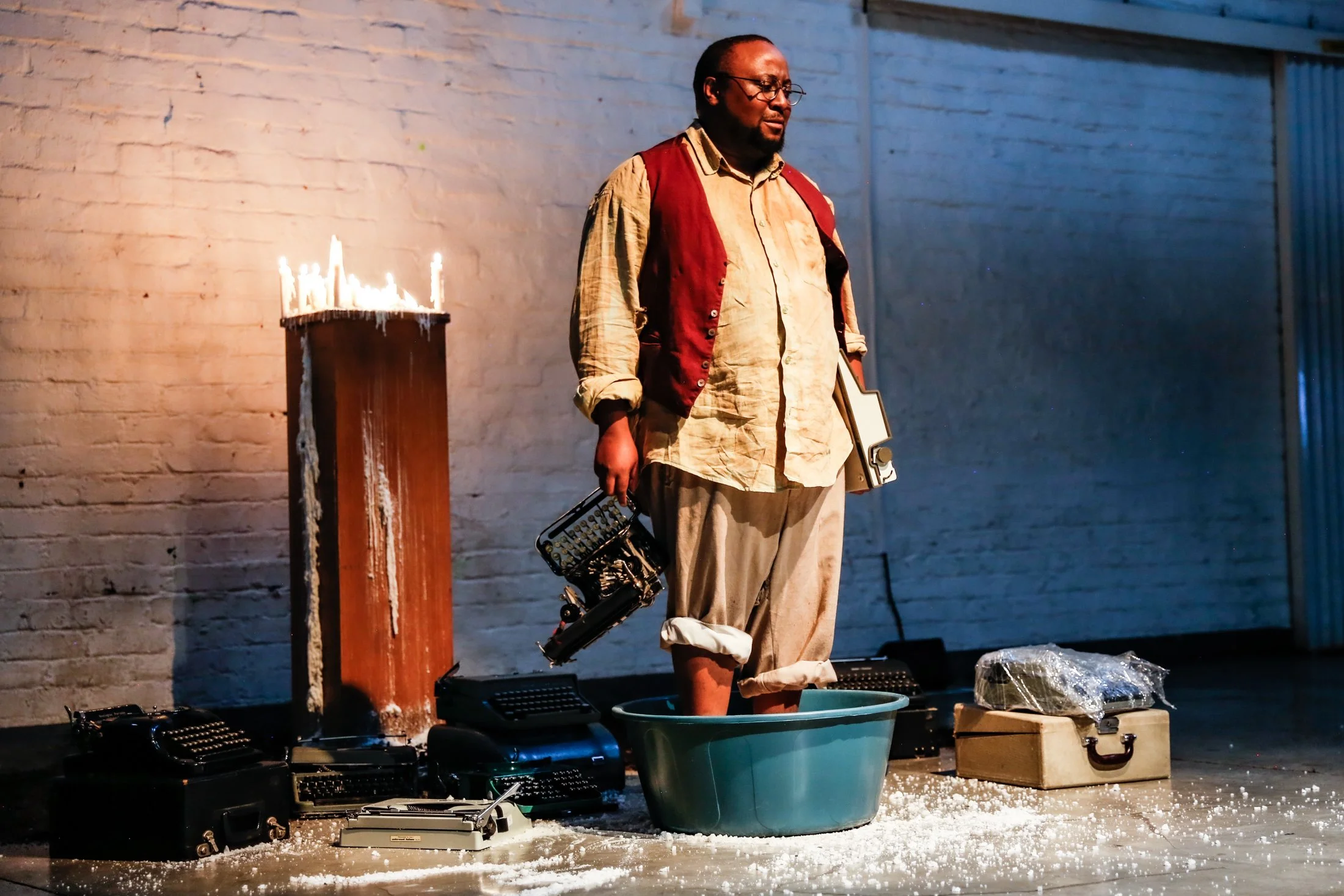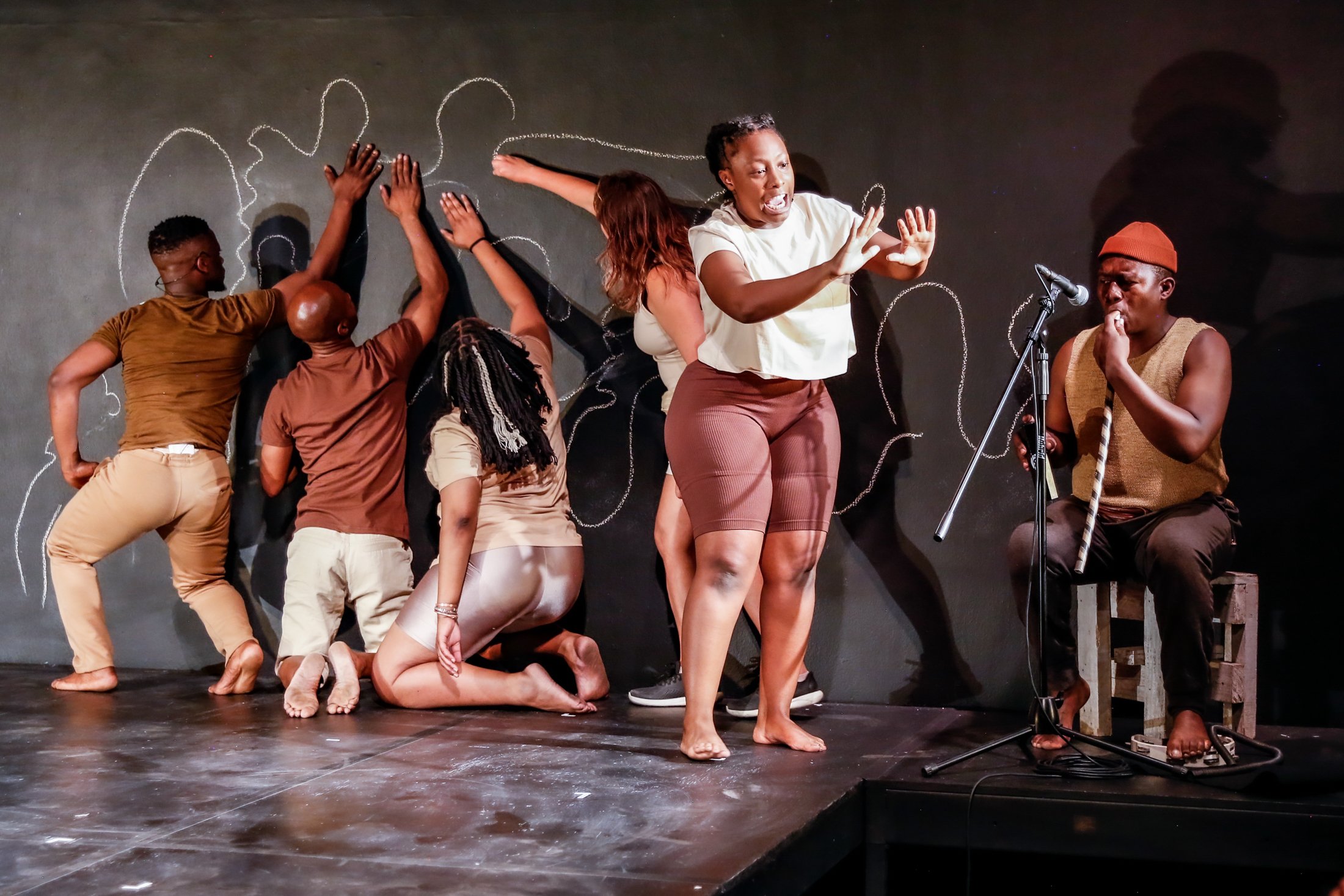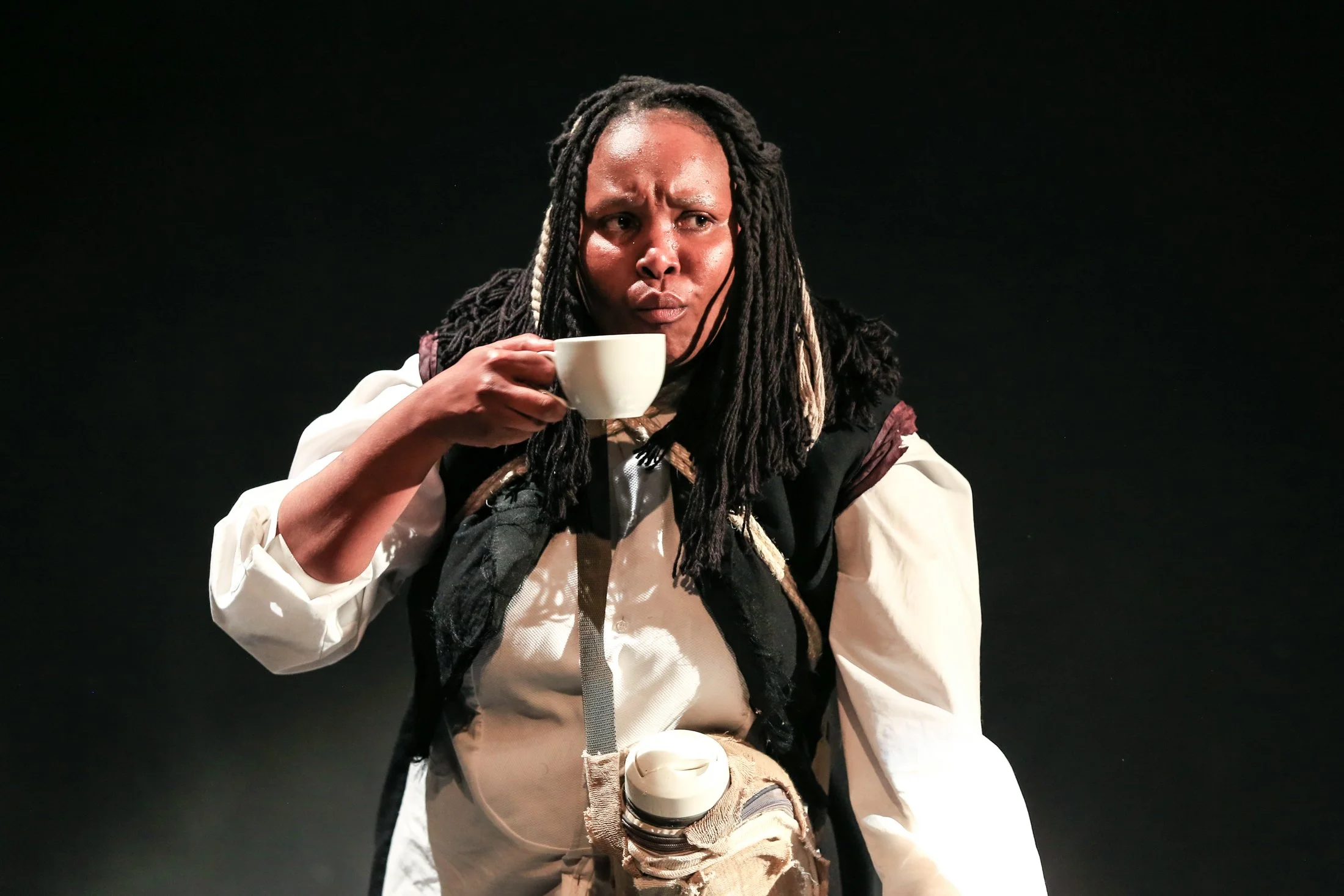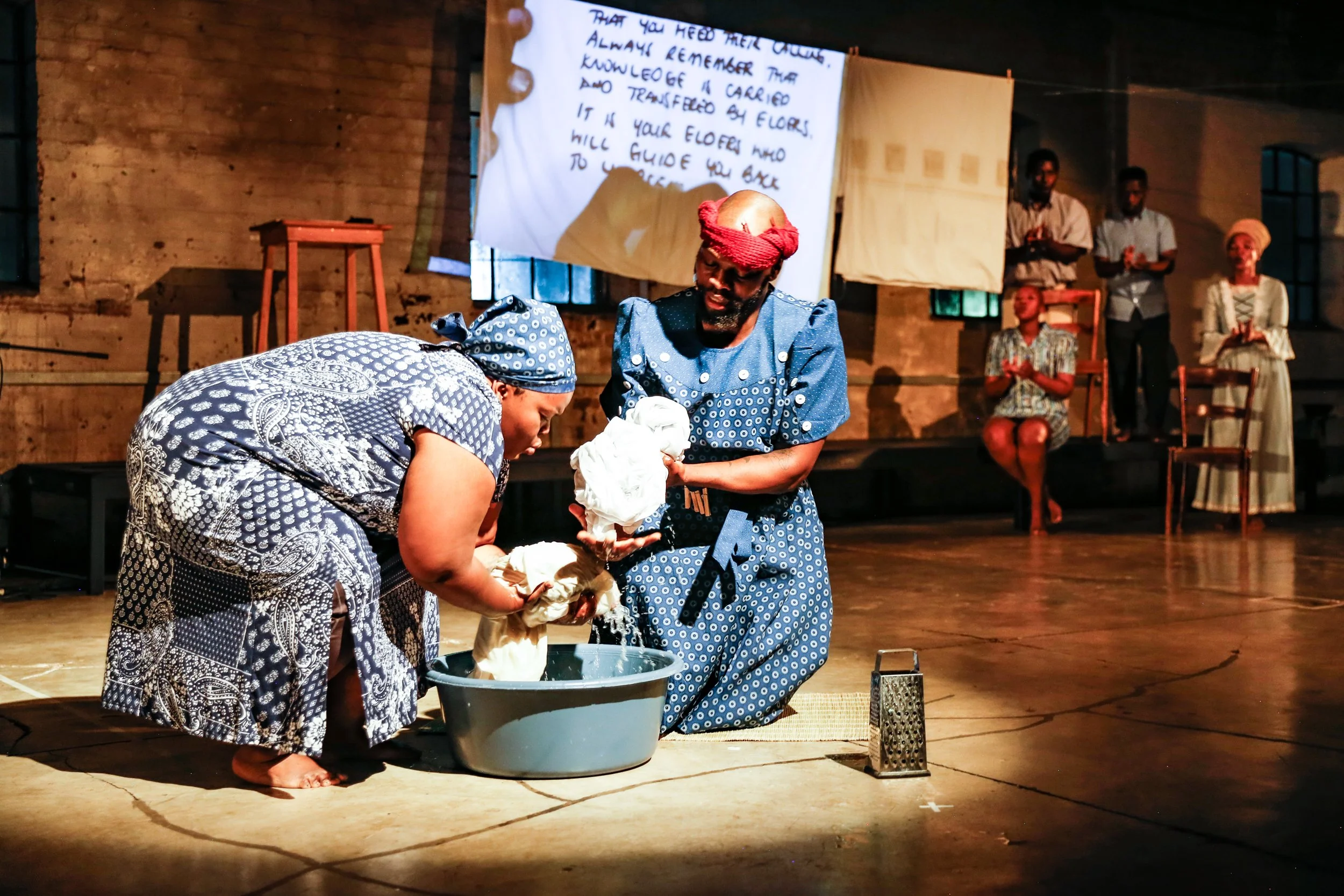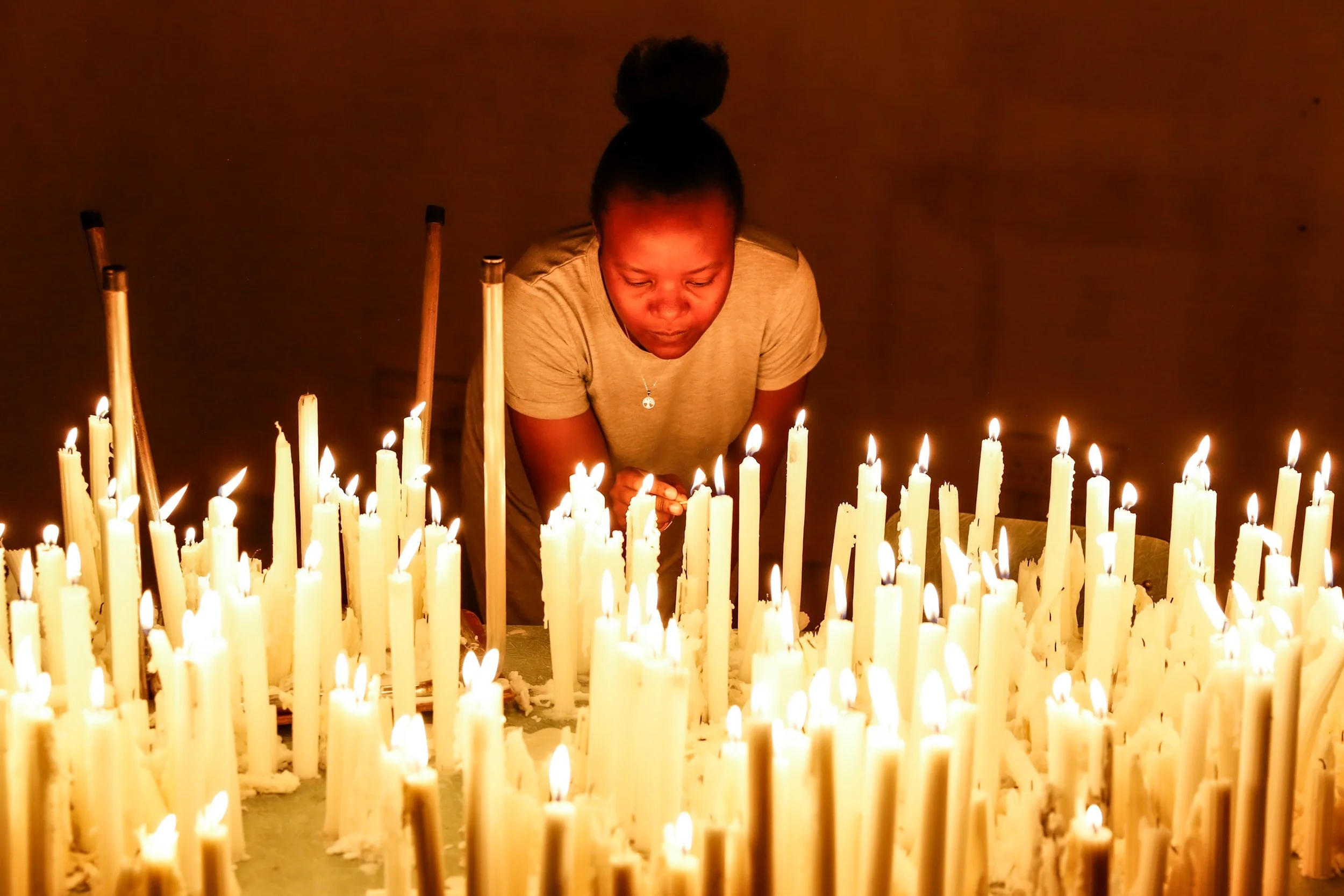SEASON 9 | CURATORIAL STATEMENT
‘Translation’ is the central provocation animating the various performances and installations that make up Season 9 of The Centre for the Less Good Idea, which took place from 26 to 30 October 2022.
Here, co-curators Mandla Mbothwe and Athena Mazarakis frame the interests, inquiries, challenges and possibilities of a Season of new collaborative and interdisciplinary creative work through two separate, but complementary texts.
Curatorial Statement – Translation #1:
Mandla Mbothwe
In response to the provocation of ‘Translation’ as a word and concept, we asked ourselves, “As story tellers of multiple tongues, what is it that we have been doing that is not Translation?”
Thina sizizi thunywa zengqiqo, ngokuphengulula nokuguqu-guqulela imiyalezo nemiyalelo.
This is a journey of translation and transformation, of transferring and transcending.
Thina sisi zithunywa. We, the message-bearers, the hauliers and carriers. Sithunyiwe!
By roots and umbilical cords through gestural sounds. Harvesting ways of knowing and planting dreams. Amathongo namaphupha. Sithi this is not the burying of meaning but the excavation of possibilities – ferrying narratives of tongues in their multiplicity. Sibekindlebe, siphuthume ubunxanxha.
The first village of translators coalesced gifts and powers of collectively summoning language; moulding it, interpreting it, translating it, transforming it. If ever there was a genesis, this was it and these were the people. It is language as a verb – a community crafting itself. Abantwa bodaka nomlilo ngabe ngomso. Progenitors of human speech, spirituality and the self – collecting coded points that mutate into information and metamorphosise into knowledge, parables and stories. Abaguquleli bezomoya nezamathongo. Vibrating idiophones and musical notes ignite motion, and dance-forms become praises and prayers.
Through the journey of translating the interpreted and interpreting the translated, we rupture all possible meanings. Tenses and senses hold multiple beings. Abombathi besikhumba sebhkhwe. We translate through time and in the process, displace time.
This journey for both the artist and curators was never innocent from political tension. What needs translation? Why? For who? What are its curses and gifts in our performances?
At the heart of what we do is the compression of knowledge in order to heal ourselves. Sicudisa ulwazi, siluguqulele ekuphiliseni uluntu. And we continue doing that as we traverse the known and the unknown. From breath to fire to kraal, stone to slope, cave drawings to paper and puppets, dreams, lights, strings, speakers, dance floors and grey tattooed concrete floors – our stories trans-mutate, altering themselves and changing us in turn. Singabaphengululi bamagada entlanti namaxhanti azo, kuba kaloku Thina sondele nokuphutshelwa.
Speaking in tongues, through the warm breath of fire, we sing the songs of earth‘s lamentations. Through our dreams, winds whisper sweet melodies of what is still to come. Izithunywa zolimo nesivuno sazo.
Listen carefully to sentences of tenses and tensions of in-betweens, to crackling sounds between crevices of knowledge(s). Learn to hear the songs as they dance in translation. Ngoma. Ingoma. Abengoma. The poetry of our bodies and the sounds of our imaginations.
Ngxe ngesi kuphosileyo-ngxe kwabo esibanyathele emsileni.
Curatorial Statement – Translation #2:
Athena Mazarakis
We are always and already in translation [from trans (Latin) – across, beyond – and latus (Latin) – carried or borne]. From impulse to gesture, idea to action, feeling to form – as performers, makers and artists, we are constantly engaged in the process of translation. Through the creative act, where experiences, perspectives, questions and insights are carried or borne across into material form, to create is to translate, and to translate is also to create.
On this foundation of translation as implicit process, Season 9 invites us into an explicit response to translation as a provocation [from provocacion (Old French, 12th Century) – incitement, urging – and provocationem (Latin) – a calling forth, a summoning, a challenge].
Our first tool as curators, in this act of incitement, urging, summoning and calling forth, was, perhaps paradoxically, the act of listening. To bring the artists into a space of deep listening, both to themselves and to each other. Ukulalela | Ho mamela | Écouter, a primary and essential step in the process of translation. We listened in order to build a village, a community for shared making, but which soon became a microcosm of our complex multilingual and multicultural society. We embodied and enacted the complexities of translation around us. The listening called forth, summoned and questioned how we translated ourselves and each other in our personal and collective response to the provocation, providing rich touch points for exploration.
While language – its translation, mistranslation, resistance to translation and what falls through the cracks of translation – is a steady beat throughout the Season, the 25 or so works that emerge in Season 9 reflect a depth of response to the layered aspects of Inguqulo| Mετάφραση | Tlhanolo | Translation.
There is the telling of old tales with new tongues; the translation of materials not only into metaphor but as portals between the world of matter and that of spirit and the translation of space – employing performance as a tool that translates site into place that is both here and somewhere else, real and imagined. There is the translation of dreams into image, sound and movement and the re-translation of those into meaning; the embedded meanings of names and how they link us to history, memory and identity and translate us in the world. There are the ways we are translated through language; the translation of roots and cultural belonging translated through our lived experiences; and the translation of material from one discipline to another. There is also the re-interpretation and intermedial translation of scores; the translation of codes across bodies, voices, objects and forms; and the translation of grief into hope.
Some of the works respond to the provocation by overtly resisting or rejecting translation. Their resistance invites a confrontation with what is lost when we find ourselves outside of a particular code, whether this be linguistic, social or cultural. At the same time, they invite an awareness of what remains available to translation while bringing the subjectivity of the translator strongly into focus.
Others shoulder the burden of translation and surface the proverbial question of what is gained but also what and who is lost in the process of translation, casting us once more in our central role as translators – bringing meaning to what we see, miss, understand and misunderstand. Central to it all is a process of translation that begins through provocation and reverberates long after the lights of this Season have gone out.
Constant Translation: The Making of Season 9
EZEMBEWU | OF THE SEEDS
It begins with Intsimbi nofela lwezandi | Sounds of skins and irons. Steady, cyclical percussion activates the space, welcoming audience members into the journey. Some sit, others move through the venue and take in the collective scene – soil and salt, the drone of voices, the low glow and flicker of candlelight.
Ezembewu | Of the Seeds, conceptualised and directed by Season 9 co-curator Mandla Mbothwe, is an immersive journey through a collection of interwoven images, songs, characters and performative moments.
Following Thabo Rapoo’s subtle, yet enduring percussion, Mhlaba Ndiyeke | Earth Leave Me Alone then surfaces the holder and excavator of the space, a figure (Anathi Conjwa) who uses ingoma to awaken and connect the various characters and elements in Ezembewu | Of the Seeds. Plagued by the constant pull of the earth, the soil upon which she moves is both a source of life and meaning, and a persistent burden.
“We seek to reclaim ourselves, our bodies, our history,” says the perpetual teacher-student (Tony Miyambo) in iDini | The Sacrifice. Haunted by archives, and unable to make sense of the present, he clings to his typewriters, the foreign appendages that they are, and communicates through the immaterial language of dreams and metaphor.
“If we are the stories we tell ourselves, what kinds of stories have we been telling ourselves?” he blurts out, nursing a typewriter like an infant on his back. It is only through the coarse rub of salt that he is able to find some respite.
The percussion rises and the collective focus moves to the troubled son (Xolisile Bongwana), faced with the burden of inherited knowledge and information, and unsure whether to retain or discard it. In Ukumumatha | The word for when you have something in your mouth and you can neither swallow, nor spit it out, water becomes a metaphor for memory. It is a moment of internal conflict rendered as frantic, frenetic choreography and moving always towards repair.
In iNimba | The Umbilical Cord, visible and invisible connections between parent (Sibahle Mangena) and child (Bongwana), earth and people, the ancestral and the living world are excavated. Here, the burden and possibility of responsibility and care are communicated through a striking duet – a holding and constraining, a pushing and pulling – that draws into a singular, significant scene of soil, fire, water and an inevitable letting go.
Loss gives way to rich possibility as the Qondiswa James-directed ensemble performance of Sizokutyala | We Are Here to Plant takes over. Here, stories are planted and nurtured in the soil, becoming dreams and possibilities, nurtured through song and slow, melodic performance, enriched by the contributions of the Duduza Serenade choir. Ultimately, it is the activity of nurturing one’s self and others – a distinct ensemble work that resonates strongly with the performances it exists alongside.
Indalo Stofile’s Skhukukazi | The Hen is a solo performance that, despite its brevity, manages to hold complex, universal notions of life, loss, death and community. Like the performance that precedes it, it is a distinct work that draws on and contributes to the greater performance programme it sits within. There is a cacophony of flailing ropes and enamel cups, the sounds of an absurd and arresting solo procession through the space by Stofile. Here, notions of motherhood, care and community sit alongside moments of profound loss and violence. The teacher-student returns, too, cleansed once more by salt, and lends a poignant narration to the scene. Ultimately, the soil becomes the final resting place of Skhukukazi and song charges the space once again. It is through an acknowledgment of life and death, loss and sacrifice, that a place of acceptance is finally reached.
The various realms, characters and performative vignettes that comprise Ezembewu | Of the Seeds ultimately speak to first translations – of soil, seeds, words, birth, growth and loss – threaded together by an aesthetic of dreams, both of the waking and the sleeping life.
– David Mann
CREDITS:
INTSIMBI NOFELA LWEZANDI | SOUNDS OF SKINS AND IRONS
PERFORMER | Thabo Rapoo
CONCEPTUALISER & DIRECTOR | Mandla Mbothwe
MHLABA NDIYEKE | EARTH LEAVE ME ALONE
PERFORMER | Anathi Conjwa
CONCEPTUALISER & DIRECTOR | Mandla Mbothwe
IDINI | THE SACRIFICE
PERFORMER | Tony Bonani Miyambo
CONCEPTUALISER & DIRECTOR | Mandla Mbothwe
UKUMUMATHA | THE WORD FOR WHEN YOU HAVE SOMETHING IN YOUR MOUTH AND YOU CAN NEITHER SWALLOW, NOR SPIT IT OUT
PERFORMER | Xolisile Bongwana
CONCEPTUALISER & DIRECTOR | Mandla Mbothwe
INIMBA | THE UMBILICAL CORD
PERFORMER | Sibahle Mangena
CONCEPTUALISER & DIRECTOR | Mandla Mbothwe
SIZOKUTYALA | WE ARE HERE TO PLANT
PERFORMERS | Duduza Serenade, Zaza Cala, Khutjo Green, Anathi Conjwa, Bongile Gorata Lecoge-Zulu, Muzi Shili, Sibahle Mangena & Kamogelo Molobye
CONCEPTUALISER & DIRECTOR | Qondiswa James
SKHUKUKAZI | THE HEN
CONCEPTUALISER & PERFORMER | Indalo Stofile
SIZINDLEBE | WE ARE EARS
From names to musical notation, and textual refrains to free-flowing movement and gesture, Sizindlebe | We Are Ears is an ensemble performance of second translations that, through a series of performative vignettes, deals with the complexity and simultaneity of translation.
Directed by Season 9 co-curator Athena Mazarakis, Sizindlebe | We Are Ears can also be seen as the second of two ensemble works responding to the Season’s central provocation of translation, the first of which was Ezembewu | Of the Seeds.
In early 2022, during the first set of ideation workshops for Season 9 of The Centre for the Less Good Idea, the 15-year-old pitch-perfect pianist Maya Muratoglu began to collaborate with a fellow workshop participant, translating a name into a set of musical notes on the piano. What then emerged as an organic moment of collaboration and play now finds striking resonance on stage as a considered yet free-flowing ensemble work.
A similar musical composition serves as the opening moment of translation – the simple act of one’s fingers on the keys of the piano – and we are content to listen. The act soon becomes troubled. Voices surface from in and around the audience, softly spoken words in various languages, until a single voice emerges and enters into a conversation with the piano, drawing out the inherent musicality and meaning of a name.
Though the piano remains a constant, translations develop and multiply throughout. There is the translation of the body in motion, the conversation that spills over into a series of mistranslations, disagreements and arguments. Text is held in gesture and music simultaneously, and language emerges, disappears, and folds in on itself.
Here, the simultaneity of translation is given room to be explored and exploded. It is translation as well-choreographed cacophony, veering at times towards entropy, but returning always to rich pockets of complexity and meaning.
– David Mann
CREDITS:
PERFORMERS | Maya Muratoglu, Kamogelo Molobye, Indalo Stofile, Zimbini Makwetu, Muzi Shili, Sibahle Mangena, Khutjo Green, Xolisile Bongwana, Thulisile Binda, Bongile Gorata Lecoge-Zulu, Nava Derakhshani, Anathi Conjwa, Pule Welch & Thabo Rapoo
DIRECTOR | Athena Mazarakis
SCORES & SCAPES | METLHALA YA DILO LE DIBAKA
MELAPO LE MELATSWANA | IMIFULA NEMI F̶U̶L̶A̶M̶B̶O̶ FULANA
MΕΤΆΦΡΑΣΗ OF IZINGUQULO | TRANSLATION OF TRANSLATIONS
NEXT TO YESTERDAY TODAY | PELE HA MAOBANE KAJENO | À CÔTÉ D'HIER AUJOURD’HUI
GUEST PERFORMANCE | A HOLE IN WAITING
The stage has become the quiet and cavernous reaches of the mines, a place of spiritual and material excavation. From above, a single light shines down from a cluster of Basotho hats suspended on a wire frame and illuminating two characters.
A Hole in Waiting, directed by Calvin Ratladi with musical composition by Xolisile Bongwana, examines the position of the body in relation to the postcolonial condition of the mining industry in South Africa. The work acknowledges the graves of thousands of people as a result of an aggressive drilling system.
Drawing on his own family history of mining, Ratladi presents a performance that centres an embodied approach to research and the theatre-making process itself. Through visual, musical and physical modes of performance, he excavates the stories embedded in the body, the bodies of those who came before him, those who have been lost to the mines, as well as the referent of the literal excavation, the land itself.
Two red blankets, a pole, a bucket, and the interactive installation of hats – over the course of the performance the hats are lowered and scattered across the stage – serve as the props that activate these modes of performance. Ratladi and Bongwana oscillate between burden and lightness – a choreography of heavy histories and potential healing – sometimes embodying both, like the striking, singular moment of Ratladi suspended on Bongwana’s back, face bathed in the deep red glow of the hats.
Light, through its presence, absence and relationship with shadows, plays a vital role in the performance. There is the soft evocation of gold, darkness, and blood, and there is the proliferation of shadows against the wall, a crush of bodies from one angle, a crowd of striking miners or the gathering of ancestors when viewed from another.
A Hole in Waiting is a performance that deals with an enduring legacy of violence, extraction, labour, suffocation and loss. Alongside the cruelty and exploitation that is at the heart of the history being grappled with, though, there are tender and contemplative moments.
“How far back do you need to travel to the beginning of history?” asks Ratladi. All of this – the relentless breathlessness, the perpetual falling and flailing – is in service of “an endless procession of fathers and grandfathers, uncles, brothers and nephews who now join their ancestors.” It is towards the excavation of grief, memory and pain. It is theatre towards healing.
– David Mann
CREDITS:
CONCEPTUALISER, DIRECTOR & PERFORMER | Calvin Ratladi
COMPOSER & PERFORMER | Xolisile Bongwana
SET & COSTUME DESIGNER | Nthabiseng Malaka
LIGHTING DESIGNER | Guy Nelson
Produced in collaboration with The Centre for the Less Good Idea. This project has been given a “Ajuts a la Creació Carlota Soldevila” Grant by Teatre Lliure, Barcelona.


